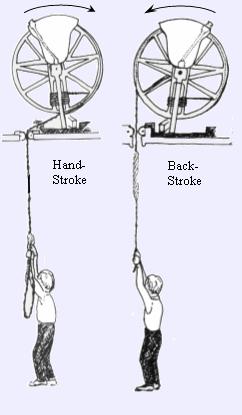| |
The Bells
and Clock of
All Saints Parish Church
Bakewell
The earliest recorded peal of bells at All Saints church, Bakewell, dates from 1616. The three original bells were augmented with a tenor, possibly by the Oldfield foundry, in 1671. Two lighter bells inscribed ‘Daniel Hedderly cast us’ were added in 1719.
|

|
A bell hung for English
Change-Ringing
 The bell can swing through just more than a full circle. At rest, the down position, the mouth of the bell faces the floor and the clapper hangs freely.
The bell can swing through just more than a full circle. At rest, the down position, the mouth of the bell faces the floor and the clapper hangs freely.
|
These six bells were replaced in 1796 with ‘..a Peal of Eight good and musical church bells of Tone and Tune..’ by Thomas Mears, London. The cost of £575 was raised by subscription with the Duke of Devonshire and the Duke of Rutland heading the list by contributing £50 each.
By 1817, however, these bells could no longer be rung due to major structural problems with the stonework beneath. Demolition of the central section of the church enabled rebuilding to start in 1841. The resulting square tower, battlemented octagon and spire height is 5 metres lower tha
n previously. New bells were commissioned and it is this peal of eight bells which sits in a timber frame behind the louvres in the octagon today. They were hung in 1895 having been cast in that year by Mears & Stainbank at the Whitechapel Foundry London.
After modifications by John Taylor of Loughborough each bell is now pivoted on ball bearings (1938) and hangs from a cast iron headstock (1960).
Although the bells are hung for change-ringing, the third bell has a hammer beneath it to strike the inside rim of the bell when a rope is pulled in the church 18 metres below. This bell is struck as a service bell before the early morning Sunday service.
|
Bell
Number |
Diameter |
Weight |
Note |
| inches |
cm |
Cwr, Qr, lb |
Kg |
1
Trebble |
29 1/2 |
75 |
5-2-22 |
290 |
E |
| 2 |
30 |
76 |
5-2-20 |
289 |
D# |
| 3 |
32 1/2 |
82.5 |
6-3-0 |
343 |
C# |
| 4 |
34 1/4 |
87 |
7-2-9 |
385 |
B |
| 5 |
37 |
94 |
8-3-24 |
456 |
A |
| 6 |
38 |
96.5 |
10-0-14 |
515 |
G# |
| 7 |
42 |
107 |
12-3-26 |
660 |
F# |
8
Tennor |
47 1/4 |
120 |
17-1-16 |
884 |
E |
| Ringing Times |
| Practice |
Thursday |
7.30-9.00pm |
| |
|
|
| Services |
Sunday |
10.15-11.00am |
| |
|
|
|
|
 Before a bell can be rung for English change-ringing it must be swung into the ‘up’ position with the mouth of the bell facing skyward. The clapper then rests against the sound bow.
Bells can be muffled for funerals by securing a leather pad to the clapper to deaden the sound. If a pad is attached to just one side of the clapper the bells are ‘half muffled’. If both sides of the clapper are fitted with leather pads the bells are ‘fully muffled’.
Before a bell can be rung for English change-ringing it must be swung into the ‘up’ position with the mouth of the bell facing skyward. The clapper then rests against the sound bow.
Bells can be muffled for funerals by securing a leather pad to the clapper to deaden the sound. If a pad is attached to just one side of the clapper the bells are ‘half muffled’. If both sides of the clapper are fitted with leather pads the bells are ‘fully muffled’. |
The Church Clock
The single clock face on the east side of the octagon beneath the spire looks toward the town centre. Behind this face, on a wooden platform 3.29 metres above the floor of the ringing chamber, sits the clock movement. Made in 1813 by John Badely of Pattingham nr. Wolverhampton it was installed one year later. Demolition of the old tower caused the original clock face to be sold in 1840. The movement was refitted a few years later when the present square tower, octagon and spire were built.
Three lead weights on wire ropes passing over pulleys then around wooden drums in the movement drive the time, quarter hour and hour chimes. The weights are raised by winding the drums weekly by hand. Mechanisms within the clock movement pull wires and levers to activate hammers which strike the outer rims of the treble and fourth bells each quarter hour. A third hammer gives the hour by striking the tenor. These hammers must be pulled away before change-ringing can commence. A pendulum of length 3.0 metres with wooden shaft and lead bob regulates the time.
|

|
|
|
artical reproduced with special permission © Robert Boyle 2001
|
|
|